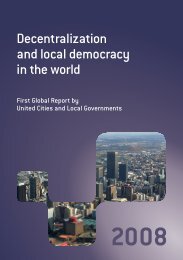Making Cities Resilient Report 2012
Making Cities Resilient Report 2012
Making Cities Resilient Report 2012
You also want an ePaper? Increase the reach of your titles
YUMPU automatically turns print PDFs into web optimized ePapers that Google loves.
Annex 4<br />
Summary of activities from cities featured<br />
Essential<br />
1<br />
Put in place<br />
organization and<br />
coordination to<br />
clarify everyone’s<br />
roles and<br />
responsibilities<br />
HFA Local<br />
indicators<br />
How well are local<br />
organizations (including<br />
local government)<br />
equipped with<br />
capacities (knowledge,<br />
experience, official<br />
mandate) for disaster<br />
risk reduction and<br />
climate change<br />
adaptation<br />
To what extent do<br />
partnerships exist<br />
between communities,<br />
private sector and local<br />
authorities to reduce<br />
risk<br />
How much does the<br />
local government<br />
support vulnerable<br />
local communities<br />
(particularly women,<br />
elderly, infirmed,<br />
children) to actively<br />
participate in risk<br />
reduction decision<br />
making, policy<br />
making, planning<br />
and implementation<br />
processes<br />
City activities<br />
Makassar, Indonesia: has a Disaster Management Agency (BNPB) to command all DRR<br />
efforts and coordinate between government department<br />
Bhubaneswar, India: set up DRR institutions at city and ward level<br />
Albay, Philippines: has central coordinating office for disaster preparedness, response<br />
and recovery<br />
Makati, Philippines: City-level DRM council has Barangay-level operating arms<br />
Quezon, Philippines: City-level DRM council has Barangay-level operating arms<br />
Dubai, UAE: creation of Crisis and Disaster Management team; developed<br />
measurements of departmental readiness<br />
Dubai, UAE: Crisis and Disaster Management team has representation from all major<br />
utilities and agencies<br />
San Francisco, Philippines: Purok structure for DRM (below Barangays) allows for<br />
participatory risk governance<br />
Colombo, Sri Lanka: task force for all actors involved in flood mitigation<br />
Pune, India: flood risk reduction managed jointly by municipal government<br />
departments and citizen groups<br />
Cape Town, South Africa: multi-stakeholder input to DRM plans (dialogue facilitated by<br />
LG-SAT); school awareness programmes in partnership with arts NGO<br />
Johannesburg, South Africa: multi-stakeholder dialogue facilitated by LG-SAT<br />
Overstrand, South Africa: partnership between government, NGOs and communities in<br />
‘Working for Water’ programme<br />
Albay, Philippines: consultation of scientific experts in risk planning<br />
Kisumu, Kenya; Mumbai, India; Istanbul, Turkey; Makati City, Philippines; Dubai, UAE:<br />
multi-lateral and bi-lateral support for DRM activities<br />
Makassar, Indonesia: NGOs involved in community development projects; school<br />
preparedness programme delivered in partnership with Indonesian Red Cross<br />
Makati, Philippines: NGO partnership for squatter relocation programme; partnership<br />
with Philippine Institute of volcanology and Seismology, and Kyoto University, Japan;<br />
first response training delivered in partnership with Philippine Red Cross<br />
Kisumu, Kenya: NGO partnership provided direct funding for DRR<br />
Batticaloa, Sri Lanka: NGO partnership supporting development activities; partnership<br />
with University of Salford<br />
Cape Town, South Africa; Makassar, Indonesia; Makati, Philippines: CSR used for DRR<br />
and disaster recovery<br />
Chacao, Venezuela: network of 33 companies in risk management network<br />
Tyrol, Austria: partnership with alpS Centre for Climate Change Adaptation<br />
Technologies to facilitate DRM planning<br />
Santa Tecla, El Salvador: citizen round tables fed into 10-year development plan<br />
Makati, Philippines: citizen participation in city planning<br />
Thimphu, Bhutan: public consultations held for 25 year Structure Plan<br />
Albay, Philippines: community contributes to local risk mapping; community-based<br />
early warning system<br />
Tyrol, Austria: risk assessment combined expert and community knowledge<br />
North Vancouver, Canada: local volunteer task forces identify ‘risk tolerance criteria’,<br />
used in city DRR activity prioritisation<br />
Bhubaneswar, India: volunteer residents trained in emergency response<br />
San Francisco, USA: Neighbourhood Empowerment Network conducts community<br />
consultations<br />
Quezon, Philippines: ‘walk the fault’ participatory risk mapping<br />
98 | <strong>Making</strong> <strong>Cities</strong> <strong>Resilient</strong> <strong>Report</strong> <strong>2012</strong>

















